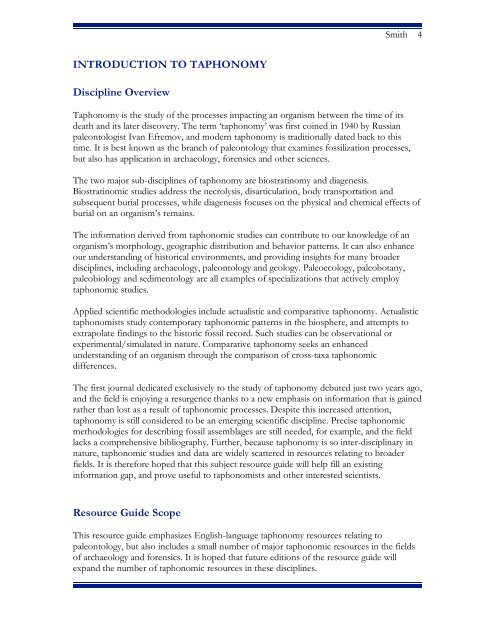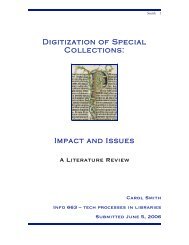Taphonomy: A resource guide - Carol Smith Home Page
Taphonomy: A resource guide - Carol Smith Home Page
Taphonomy: A resource guide - Carol Smith Home Page
You also want an ePaper? Increase the reach of your titles
YUMPU automatically turns print PDFs into web optimized ePapers that Google loves.
INTRODUCTION TO TAPHONOMY<br />
Discipline Overview<br />
<strong>Smith</strong> 4<br />
<strong>Taphonomy</strong> is the study of the processes impacting an organism between the time of its<br />
death and its later discovery. The term ‘taphonomy’ was first coined in 1940 by Russian<br />
paleontologist Ivan Efremov, and modern taphonomy is traditionally dated back to this<br />
time. It is best known as the branch of paleontology that examines fossilization processes,<br />
but also has application in archaeology, forensics and other sciences.<br />
The two major sub-disciplines of taphonomy are biostratinomy and diagenesis.<br />
Biostratinomic studies address the necrolysis, disarticulation, body transportation and<br />
subsequent burial processes, while diagenesis focuses on the physical and chemical effects of<br />
burial on an organism’s remains.<br />
The information derived from taphonomic studies can contribute to our knowledge of an<br />
organism’s morphology, geographic distribution and behavior patterns. It can also enhance<br />
our understanding of historical environments, and providing insights for many broader<br />
disciplines, including archaeology, paleontology and geology. Paleoecology, paleobotany,<br />
paleobiology and sedimentology are all examples of specializations that actively employ<br />
taphonomic studies.<br />
Applied scientific methodologies include actualistic and comparative taphonomy. Actualistic<br />
taphonomists study contemporary taphonomic patterns in the biosphere, and attempts to<br />
extrapolate findings to the historic fossil record. Such studies can be observational or<br />
experimental/simulated in nature. Comparative taphonomy seeks an enhanced<br />
understanding of an organism through the comparison of cross-taxa taphonomic<br />
differences.<br />
The first journal dedicated exclusively to the study of taphonomy debuted just two years ago,<br />
and the field is enjoying a resurgence thanks to a new emphasis on information that is gained<br />
rather than lost as a result of taphonomic processes. Despite this increased attention,<br />
taphonomy is still considered to be an emerging scientific discipline. Precise taphonomic<br />
methodologies for describing fossil assemblages are still needed, for example, and the field<br />
lacks a comprehensive bibliography. Further, because taphonomy is so inter-disciplinary in<br />
nature, taphonomic studies and data are widely scattered in <strong>resource</strong>s relating to broader<br />
fields. It is therefore hoped that this subject <strong>resource</strong> <strong>guide</strong> will help fill an existing<br />
information gap, and prove useful to taphonomists and other interested scientists.<br />
Resource Guide Scope<br />
This <strong>resource</strong> <strong>guide</strong> emphasizes English-language taphonomy <strong>resource</strong>s relating to<br />
paleontology, but also includes a small number of major taphonomic <strong>resource</strong>s in the fields<br />
of archaeology and forensics. It is hoped that future editions of the <strong>resource</strong> <strong>guide</strong> will<br />
expand the number of taphonomic <strong>resource</strong>s in these disciplines.





